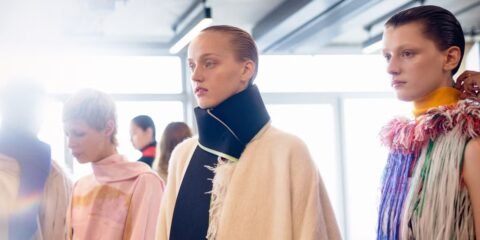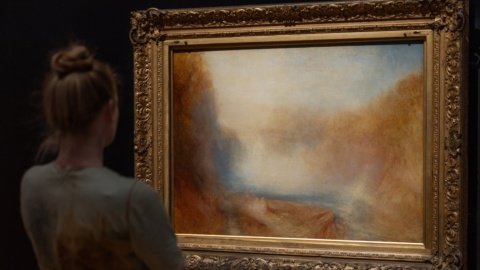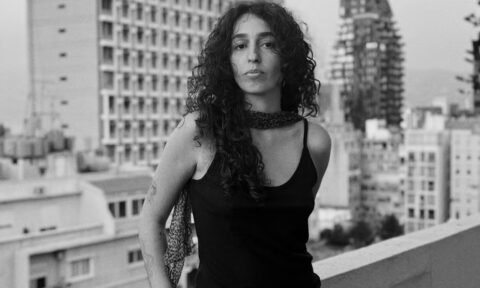Arab Pop Art: Between East and West, now open
Bright colors, cultural symbols, and social and political commentary abound in a new exhibit at the Middle East Institute in Northwest D.C. Arab Pop Art: Between East and West features works by 14 artists from the Arab world and its diaspora, including local D.C. creatives Helen Zughaib and Yusef Alahmad.

The show’s 35 vibrant artworks are rich with heritage, humor, satire, and street culture and, taken together, the exhibition explores the evolution of Arab pop art, which blends the visual language of Western pop art from the ’60s with cultural motifs and commentary on issues relating to the SWANA (Southwest Asia and North Africa) region. Curators Laila Abdul-Hadi Jadallah and Lyne Sneige are both deeply involved in the cultural diplomacy work of MEI’s Arts and Culture Center to promote cross-cultural understanding. “The exhibition illustrates how Arab artists not only enrich the broader Pop Art movement but make it their own by drawing from the Arabic language, and cultural motifs,” Abdul-Hadi Jadallah says. “Through their own visual language and inventiveness, these artists invite us to see the multiplicity and richness of the Arab world simultaneously through a historical and contemporary lens.” Arab Pop Art: Between East and West opened on Sept. 12 and runs through Jan. 23 at the Middle East Institute. mei.edu. Free. —Laura Zee
Vincent Ricardel: Chasing Light, now open

Artists generally, and photographers specifically, tend to adhere to a visual style, if not for an entire career then at least in successive projects. Vincent Ricardel breaks that mold. The 15 images by Ricardel on display at gallery neptune & brown are mostly observational photographs in urban and natural areas, but stylistically, they are all over the map. (Geographically, too—from D.C. to California, Hawaii to Tokyo and Seoul.) Alternating between black-and-white and color, Ricardel channels Karl Blossfeldt’s botanicals, Harry Callahan’s ultra-high-contrast of snow and sand, Eugène Atget’s Parisian streetscapes, Andy Warhol’s matrices of muddily rendered faces, and Henri Cartier–Bresson’s “decisive moment”—in Ricardel’s case, an image featuring a girl, a cat, and more than a dozen pigeons, each in motion. Ricardel even hat-tips Katsushika Hokusai’s famous wave, with an unexpectedly dark moodiness, seemingly threatening a mostly submerged figure nearby. In one moment, Ricardel uses black and white to capture people walking through five stories of art deco windows in Philadelphia’s 30th Street Station; in another, he’s photographing the peacefully rippled surface of a pool in Tokyo’s Imperial Garden, limned in surprisingly harmonious shades of purple and green. Some images work better than others; one made in Santa Monica featuring wet pavement, a dazzlingly starry sky, several palm trees, and a child comes off as overproduced, but another Santa Monica image, with three wispy figures within a minimalist beach dreamscape, hits just the right note. Ricardel’s work often involves partial or bent legs—one foot emerging from a building window, several belonging to ballerinas, one belonging to the girl with the pigeons, one from a cross-legged man partially obscured by a tree, one sticking out of the water in East Hampton, New York, and a pair belonging to schoolgirls on a sidewalk, captured as they’re walking out of the frame. For a photographer with such divergent styles and methods, this habit counts as the one unifying theme of Ricardel’s work. Vincent Ricardel: Chasing Light opened on Sept. 13 and runs through Oct. 25 at gallery neptune & brown. galleryneptunebrown.com. Free. —Louis Jacobson
Rik Freeman: Wade in the Waters opens Sept. 24

As he explains it, Rik Freeman tends to center his work on the history of people of African descent in the Americas. “Given the day, the time, the era that we’re in right now … I think people really need to pay a little more attention to that, and what is being excluded and what should be remembered,” Freeman says. The D.C. muralist and painter is well-known for his narrative works that focus on the African diaspora over hundreds of years of Black history, centering the stories of the “everyday person,” he says. “Malcolm, Martin, everybody else—they stood on the shoulders of the everyday person.” Freeman’s newest exhibit, Wade in the Waters, includes works on canvas that have to do with water, pulling from three of his existing historical series: The Chittlin’ Circuit Review, based on the early history of Blues music, Black Beaches During Segregation, and BAHIA!, about the African contribution to Brazil’s history and culture. “My works pretty much all tell a story,” he says, and the stories within Wade in the Waters are full of history, community, resilience, joy, and faith. A special free exhibit opening event takes place on Sept. 25 where hors d’oeuvres will be served, and the artist will be in attendance. Rik Freeman: Wade in the Waters opens on Sept. 24 and runs through Feb. 19 at the Phillips@THEARC. phillipscollection.org. Free. —Laura Zee
Women Artists from Antwerp to Amsterdam, 1600–1750, opens Sept. 26

Many are likely familiar with the painters of the Dutch Golden Age: Rembrandt, Johannes Vermeer, and the like. But women artists also flourished at the same time, contributing to the era’s unprecedented expansion of trade, luxury goods, and art. They also weren’t just in the Netherlands: Flanders, the Dutch-speaking northern region of Belgium, boasted many talented women artists. This fall, the National Museum of Women in the Arts exhibit Women Artists from Antwerp to Amsterdam, 1600–1750 will highlight 150 works by more than 40 Dutch and Flemish women artists who were actually quite famous at the time. “Women artists were so well known during their lifetimes––it’s not that they were working in obscurity,” senior curator Ginny Treanor says. “They were published, they had poems written about them, they were like superstars, and yet today we don’t know a lot about them.” Artists featured include Gesina ter Borch, Maria Faydherbe, Anna Maria de Koker, Judith Leyster, Magdalena van de Passe, Clara Peeters, Rachel Ruysch, Maria Tassaert, Jeanne Vergouwen, Michaelina Wautier, and others. But as Treanor notes, it’s not just about painting: lace, prints, paper cuttings, embroidery, and sculpture are also featured in the exhibit. “If we focus only on painters, a lot of times that’s women and men of a certain class,” she says. “Let’s broaden the definition. Let’s talk about what else was going on at the time and how women were involved in that.” And while these goods may be devalued as simple crafts of women’s work, they were key players in the artistic world. Their work was often shared with aristocratic social circles, sold at markets, or commissioned by patrons. “I really hope that visitors come away knowing that there were women artists in this period that were really integral to the artistic economy of the time,” Treanor adds. Women Artists from Antwerp to Amsterdam, 1600–1750 opens Sept. 26 and runs through Jan. 11 at the National Museum of Women in the Arts. nmwa.org. $13–$16. —Hannah Docter-Loeb
New Member Exhibit: Russell Barajas & Guillermo Olaizola, opens Oct. 14

Only occasionally does Alexandria’s Multiple Exposures Gallery admit new members to its artist collective. This fall, they’ll be welcoming two newcomers—Russell Barajas and Guillermo Olaizola—and launching their membership with a joint exhibit. Barajas lives in Arlington, by way of Northern California, while Olaizola lives in Bethesda after emigrating from Venezuela in 2002. Barajas, a onetime goldsmith’s apprentice, will exhibit works made from old-school darkroom printing techniques, enhanced with hand-applied oil paint. She calls her approach to photography “decidedly eccentric.” Olaizola, for his part, will be exhibiting a series of close-up images of the travertine formations at Mammoth Springs in Yellowstone National Park. “Over time, my artistic vision has evolved toward a minimalist aesthetic: I’m drawn to simplicity, elegance, and the emotional resonance that can emerge from just a few carefully chosen elements,” Olaizola says.

Both Barajas and Olaizola describe the process of applying to become a new member of the collective as intense. “It was both daunting and wonderful,” Barajas says. “It was not dissimilar to applying to a Master of Fine Arts program. Just the application process alone is such a valuable experience. One needs to present a coherent portfolio with a current and cohesive series of images, and also a smaller set of supplemental images that differ from the main series. There are also interviews with the current members, which was actually entirely enjoyable.” Portraits of Life and Land: Russell Barajas & Guillermo Olaizola opens Oct. 14 and runs through Nov. 23 at Multiple Exposures Gallery at the Torpedo Factory Art Center. multipleexposuresgallery.com. Free. —Louis Jacobson
Tawny Chatmon: Sanctuaries of Truth, Dissolution of Lies, opens Oct. 15
Tawny Chatmon describes her works as “photography-based”—they begin, but hardly end, with a photograph. Chatmon, a Maryland-based artist who will mount her first D.C. museum show in October at the National Museum of Women in the Arts, has produced several series in which she layers images—usually reflecting Black culture—with mixed media, including gold leaf, paint, fabric, glass beads, thread, and shells.

Chatmon, who initially worked in commercial and editorial photography, photographed her father’s battle with cancer, before turning to art full-time. Some of Chatmon’s most dazzling works reference the gold-laced, art nouveau paintings of Gustav Klimt. Others operate within the style of Byzantine gold-leaf mosaics. In recent years, Chatmon has moved away from using real gold in her works, amid concerns about the conditions for gold miners and processors in countries like the Democratic Republic of the Congo. In one series she’s worked on since 2024, The Reconciliation, Chatmon depicts foods associated with the African diaspora, in one case reclaiming the watermelon. In another series she’s worked on since 2024, The Restoration, Chatmon transforms antique dolls and figurines that demean or stereotype Black Americans, selectively repainting and reclothing them and photographing children playing with the new versions. Tawny Chatmon: Sanctuaries of Truth, Dissolution of Lies opens Oct. 15 and runs through March 8 at the National Museum of Women in the Arts. nmwa.org. $13–$16. —Louis Jacobson
Anonymous Was a Woman, opens Oct. 16

The Anonymous Was a Woman grant program has funded more than 600 women artists since its inception in 1996, and four of them are artists currently living and working in the DMV. A recent exhibit at New York University’s Grey Art Museum celebrated the first 25 years of the grant and featured works from the artists created around the time they were in the program. Now, an exhibit at the Kreeger Museum will showcase more recent works from the four legendary locals. Most of these pieces were created this year, so they take an up-to-the-minute view of how these women are currently creating and what they’re putting out into the world, offering a window into the richness and variety of approaches in the area’s art scene. Joyce J. Scott brilliantly applies artisan techniques like quiltmaking and beadworking to her intricately bedecked sculptures, and will have a sculpture of gloriously decorated upraised hands gathered around a woman. She has also created an intricate wall hanging that uses a staggering amount of teensy glass beads to render amazingly detailed scenes, a testament to Scott’s mastery of this technique. Craft is also of interest to Jae Ko, who soaks, twists, shapes, and dyes paper until it becomes forms that are both organic and orderly, like something created by an industrious insect. Undulating forms come through as well in the paintings of linn meyers, who builds up thousands of minute strokes to create abstract patterns reminiscent of waves, fields of grass waving in the breeze, cloud patterns, or the cosmos themselves. Watching over it all will be Renee Stout’s painting “I Trust My Third Eye,” an acrylic with many roving eyes. Stout’s work often deals in the mystical—specifically hoodoo magic—as well as politics and current events. In a time when there’s surveillance everywhere and trust is in short supply, the title of her piece offers some good advice. Anonymous Was a Woman opens Oct. 16 and runs through Dec. 31 at the Kreeger Museum. kreegermuseum.org. $10-15. —Stephanie Rudig
Water’s Edge: The Art of Truman Lowe, opens Oct. 24

Acclaimed Hoocąk multidisciplinary artist Truman Lowe is known for turning wood into water. This fall, nearly 50 of his works will be featured in a new retrospective, Water’s Edge: The Art of Truman Lowe, at the National Museum of the American Indian. From the moment you walk into the museum, you’re engaging with Lowe’s work; he was the curator of contemporary art at the NMAI from 2000 to 2008 (the museum opened on the National Mall in 2004). But Lowe’s legacy expands far beyond the walls of any one gallery: He was a professor, advocate, mentor, and supporter of Indigenous artists as well as the first person of color to have a building named after them at the University of Wisconsin—but the upcoming retrospective is a rare opportunity to see many of his own works in one place. Water’s Edge will be the first major exhibit of Lowe’s work since his passing in 2019. It includes pastels, charcoal drawings, his signature sculpture work, and large-scale installations made of blue jay feathers, willow branches, leather, and more. These organic materials “evoke the rivers, streams, and waterfalls of the Wisconsin woodlands where he was raised and the canoes used to traverse them,” according to NMAI. The exhibit’s title refers to these waterways, and to the many ways in which water has featured in his work. In an interview for the University of Wisconsin, Lowe once described his reason for creating art about water: “I have an interest in trying to protect as much of the environment as possible,” he said. “I want to create enough interest in water through my work that others will begin to share the same beauty and the same understanding that I have of moving water. It’s really about that.” Water’s Edge: The Art of Truman Lowe opens on Oct. 24 and runs through January 2027 at the National Museum of the American Indian. americanindian.si.edu. Free. —Laura Zee
Karen Keating: I Come From …, opens Oct. 25

Karen Keating recently stepped down after decades in senior roles with Photoworks, the photographic community and gallery in Glen Echo. This fall, Keating will be honored with a retrospective exhibit, curated by fellow photographers Diane Charnov and Tom Sliter. The exhibit will feature 40 black-and-white prints made in a variety of locales, including Cuba, Honduras, and her native Coshocton, Ohio. One series documents D.C. in the 1970s, including portrayals of mothers and daughters. Another features outdoor nightscapes in a small New Hampshire town. Others are still lifes not linked to a particular place. All, however, are made from old-school film and developed in the darkroom—skills that Keating taught for years at Photoworks and refined through monthly “coffee and critique” events with colleagues. Karen Keating: I Come From … opens Oct. 25 and runs through Dec. 7 at Photoworks in Glen Echo. glenechophotoworks.org. Free. —Louis Jacobson
Big Things for Big Rooms, opens Nov. 21

Size doesn’t matter, except when it does. Modern art museums like to give space and room to breathe between works, but they also like sensational installations and mammoth pieces that viewers could literally get lost in. The Hirshhorn’s expansive ring galleries can sometimes host hundreds of artifacts within a single exhibit, but Big Things for Big Rooms will zero in on just 10 oversize works. The exhibit traces how installation art came about with movements such as Land Art and the Light and Sound movement, both of which emphasized scale and how a space is occupied. The works featured engage with the idea of artistic environments, or works that need to be walked around or inhabited, and often require interaction or a scale relationship to a viewer to be really “finished.” Installation these days trend toward “immersive” or VR experience, but before all that, installation artists used lighting, audio, and other sensations, as well as the shaping of the physical space itself, to create the intended effect for viewers. Hometown hero Sam Gilliam’s “Light Depth” is prominently featured, one of the artist’s best known works that pioneered his technique of painting and dyeing unstretched canvas, and then draping it in hanging formations that further contort it from painting to sculpture. Other early examples of installation art show how the discipline evolved over time, while some show what is happening in current practice. A shipping container taking up a huge chunk of the gallery will serve as a screening room for Mika Rottenberg’s video work “Tropical Breeze,” which itself features a woman driving a truck while a woman powers a Rube Goldberg-esque bicycle machine in the truck bed that passes tissues up to the driver. Rashid Johnson, who works as a portrait photographer, filmmaker, mosaic artist, and art historian, among other things, will be creating a sculptural assemblage specifically for this show that will include live plants and ceramics, and can be retooled as a performance space. Get ready to step inside the art, and maybe even become part of it. Big Things for Big Rooms opens Nov. 21 and runs through July 4, 2027, at the Hirshhorn Museum and Sculpture Garden. hirshhorn.si.edu. Free. —Stephanie Rudig
For the rest of City Paper’s 2025 Fall Arts Guide, check out How To Make a Scene, where you’ll find lit, film, museum, music, theater, dance, and performance event recommendations.




